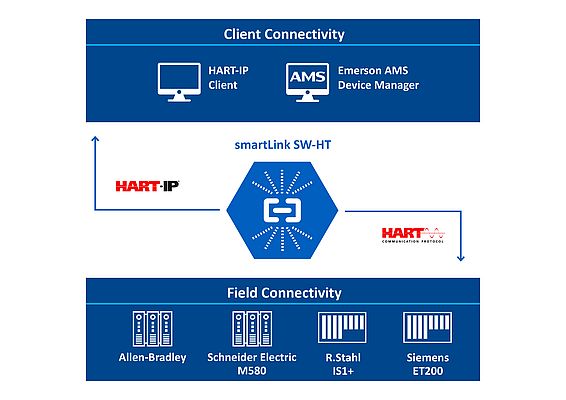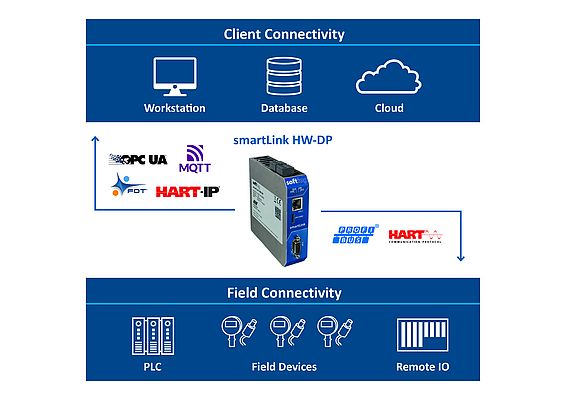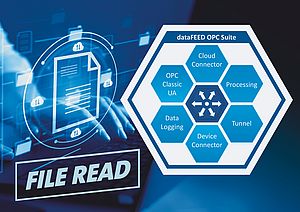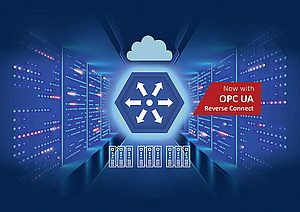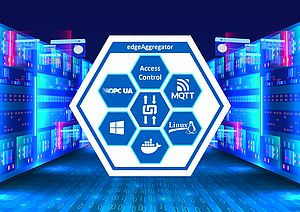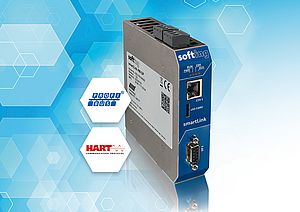Raw material scarcity and high energy bills are increasing the pressure on users to optimize their plants and processes. This is where digitalization in process engineering facilities can offer a wide range of options. For system owners, the main advantage here is achieving high productivity at low cost, with efficiency and availability also being decisive factors. Disruptions to production and unplanned system shutdowns are key pain points here, so the idea is not merely to respond quickly to faults if and when they happen but also to identify potential malfunctions at an early stage and take preventive action that will avoid expensive downtime.
The primary tool used for these tasks is Plant Asset Management (PAM), which aims to give facility owners a comprehensive set of data about the state of their systems. Alongside the process data the control works with, this dataset includes diagnostic data for the individual components as well as asset data that provide information about the installed components and units. To extract useful information from all of this data, it needs to be available to higher-level systems such as the Plant Asset Management system. So how can transparent access be provided to all of these data? Answering this question is a key issue for many plant owners.
Heterogeneity is the rule on the ground
One specific challenge in this context is the sheer volume of field devices that are in use in the process industry. A further difficulty is a lack of homogeneous interfaces. Traditional connectivity using 4…20 mA is still often found here, with digital integration typically using remote I/O modules via the Hart protocol. A mix of other protocols like PROFIBUS PA or FOUNDATION Fieldbus may also be deployed in the same plant.
This means that, in many cases, users have only been able to integrate some of their field devices with PAM to date. In addition, these structures make field device parameter setting more complex. During operations, making use of these data in Plant Asset Management also requires other steps to be taken, which means that maintenance activities cannot be planned according to demand. The result is a higher risk of an unplanned plant shutdown.
Simple, fast access to Hart field devices
But help is at hand with products from Softing Industrial Automation’s smartLink family. First up is smartLink SW-HT, which provides a software-based Hart multiplexer and an integrated Hart IP Server that facilitates transparent communication over the open Hart IP protocol. The Hart IP Server provides higher-level Hart IP-compatible applications with simple and secure access to Hart field devices. Typical examples here include Emerson AMS Device Manager, ABB Field Information Manager, or Endress+Hauser Netilion.
As a Docker container, smartLink SW-HT can be used on standard hardware and managed using industry-standard solutions for container management. In the corresponding system environment, the product therefore provides various opportunities for highly efficient and scalable operation. Alternatively, smartLink SW-HT can also be configured as a virtual machine.
In this case, the software multiplexer uses the existing hardware to access Hart field device data and makes these available within the plant network. A lean solution like this offers obvious advantages: apart from avoiding extra spending on hardware, this option also avoids the need for hardware installation or maintenance. Thanks to its browser-based configuration interface, commissioning is also very straightforward with smartLink SW-HT.
To set parameters on the connected field devices, the corresponding Hart commands are sent to the Hart IP Server, which forwards these transparently to the corresponding field devices. Any Hart command can be used without restrictions and smartLink supports many remote I/O modules from leading manufacturers, including Allen-Bradley, Siemens, Schneider Electric, or R. Stahl. Licensing costs are based on the number of Hart field devices to be integrated.
Gateway solution for Hart and PROFIBUS
Alongside the software-based smartLink SWHT product, Softing’s smartLink HW-DP provides a hardware solution for accessing field devices. The gateway can act as a PROFIBUS DP master, which provides an access point to a PROFIBUS DP segment and lets existing PROFIBUS segments run inside a digitalized environment and integrate with Industry 4.0 solutions.
Centralized field device parameter setting from the control room is also possible here, which lets users work independently of respective project planning tools. PAM applications are granted access to field device configuration based on the FDT/DTM and EDDL standards, with smartLink HW-DP being configurable for use as a Hart IP Server, OPC-UA Server, or MQTT Publisher. This therefore enables the use of a second, parallel communication channel as specified by the Namur Open Architecture (NOA), which feeds the data to the higher-level Industry 4.0 applications without any need for interventions into the control architecture.
A strong track record
Softing has already used smartLink to successfully complete numerous projects. In petrochemical applications, for example, several hundred Hart field devices have been integrated with a PAM system. VMware was used here for the installation of smartLink SW-HT on an IPC used by the Plant Asset Management system.
In a process industry project, more than 60 smartLink HW-DP gateways were deployed to provide an Emerson AMS Device Manager with access to Hart field devices connected via remote I/O modules from R. Stahl. There are also many other examples from different areas of manufacturing where solutions from the smartLink product family are providing users with access to Hart and PROFIBUS devices for their PAM systems. Softing’s smartLink solutions grant access to all of the many kinds of information available from the installed base of smart field devices. This, in turn, gives users access to a data-driven approach to their work that allows them to make informed decisions about optimizing plant operations, ultimately resulting in improvements both to efficiency and availability.
Author: Dr. Christopher Anhalt, Vice President Product Marketing, Softing Industrial Automation GmbH


